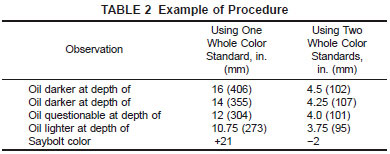10. Procedure for Refined Light Oils and Pharmaceutical White Oils
10.1 Flush the oil tube with a portion of the test specimen, taking care to allow the tube to drain thoroughly. Fill the oil tube with the test specimen compare with a whole color standard. When the test specimen is lighter than the color standard, remove the standard and replace it with a half standard. When the sample is darker than the single whole standard at 6 1/4 in. (158 mm), add another whole standard. (Warning - It is important that all samples in the color tubes be free from air bubbles.)
10.2 With the proper color standard or standards in place, and the test specimen in the oil tube at a level where its color is decidedly darker than that of the color standard, draw off the test specimen slowly by means of the petcock until the oil appears just slightly darker than the color standard. From this point, draw the test specimen level down to the nearest depth corresponding to color number as shown in Table 1. When the color of the oil observed through the eyepiece is still darker than the color standard, draw the oil down to the next depth given in Table 1, and compare. Continue this operation until a depth is reached where the test specimen and color standard match, or show questionable differences. At this point, lower the oil column to the next specified depth and, when the oil is unmistakably lighter than the color standard, record the color corresponding to the next higher level as the Saybolt color.
10.3 Experience in the use of this instrument will obviate the necessity of following the step-by-step procedure outlined in 10.2 for choosing the proper color standards for each sample. Examples of the procedure are given in Table 2.

11. Procedure for Petroleum Wax
11.1 Heat the wax test specimen to 8 to 17°C above its congealing point as determined in accordance with Test Method D938. Preheat the oil tube.
11.2 Pour the liquid wax into the oil tube; turn the heating element off, and, after the heat waves in the test specimen can no longer be noted, obtain the required readings as directed in Section 10.



